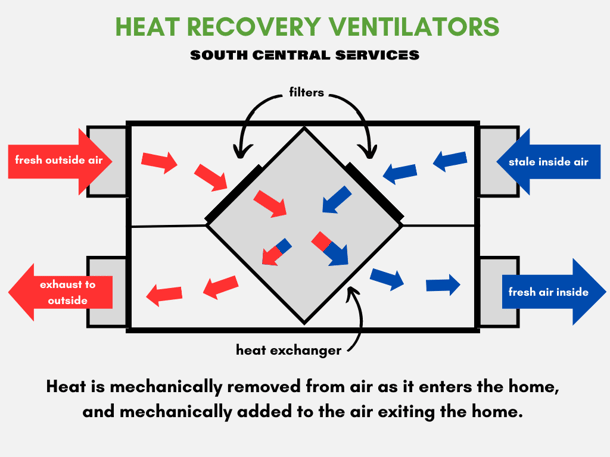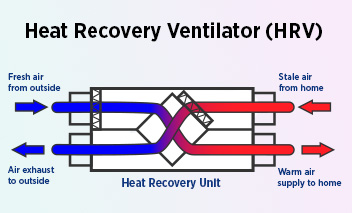Introducing the Key Conveniences and Uses of Heat Recovery Ventilation in Sustainable Style
Heat Recovery Ventilation (HRV) systems play an essential duty in lasting design. They help with a continual exchange of stale indoor air with fresh exterior air, considerably enhancing interior air high quality. HRVs add to power effectiveness by recovering heat from tired air, which can decrease energy costs. Understanding the multifaceted benefits and applications of HRVs discloses their relevance in modern style. What other advantages do these systems use in the quest of sustainability?
Understanding Heat Recovery Ventilation Systems
Heat recovery ventilation (HRV) systems are designed to boost interior air top quality while lessening power loss. These systems utilize a mechanical ventilation method to exchange stagnant interior air with fresh outdoor air, making certain a continuous supply of clean air. By capturing warm from the exhaust air, HRVs precondition inbound air, lowering the demand on heating and cooling down systems. This procedure not only improves thermal convenience but also adds to energy efficiency in property and commercial structures. Additionally, HRV systems help manage moisture levels and decrease indoor pollutants, advertising a much healthier living setting. Their calculated execution is important for attaining sustainable style goals, as they provide an equilibrium between energy preservation and resident wellness.
Exactly How HRV Solution Work
While many may know with air flow systems, understanding exactly how heat recovery ventilation (HRV) systems run is vital for valuing their benefits. HRV systems work by trading stale interior air with fresh outside air while transferring warm between both streams. This procedure takes place in a heat exchanger, where warmth from the outbound air warms up the inbound air during cooler months, decreasing energy loss. Alternatively, in warmer months, the system can cool down inbound air using the cooler outgoing air. HRVs are furnished with fans to assist in airflow and filters to remove particulates, guaranteeing a continuous, well balanced air flow process. This ingenious design not just boosts energy effectiveness but likewise contributes to keeping a comfy interior setting.
Enhancing Indoor Air Quality
Indoor air quality can greatly impact health and health, making effective air flow essential in modern-day homes. Heat Recovery Ventilation (HRV) systems play a necessary duty in maintaining interior air quality by continuously exchanging stagnant indoor air with fresh outdoor air. This process not just reduces airborne toxins however also minimizes moisture degrees, which can cause mold and mildew development and breathing issues. HRV systems filter incoming air, getting rid of allergens and particulates, thus providing a healthier living atmosphere. In addition, these systems aid get rid of smells and unpredictable organic substances (VOCs) commonly located in family items. By making certain a consistent flow of tidy air, HRV systems contribute to a general better interior ambience, promoting convenience and well-being for residents.
Power Effectiveness and Cost Savings
Energy efficiency attracts attention as a considerable advantage of Heat Recovery Ventilation (HRV) systems. By recording and recycling the heat from tired indoor air, HRVs minimize the power needed for heating incoming fresh air, leading to reduced power intake. This efficiency translates into lower utility expenses, supplying considerable price financial savings for house owners and businesses alike. In addition, HRV systems usually get power performance motivations and rebates, better boosting their economic appeal. Over time, the first financial investment in HRV technology can lead to a positive roi through reduced power expenses. The assimilation of HRV systems not only advertises sustainable layout yet likewise provides a useful remedy for accomplishing long-lasting power cost savings and financial advantages.
Ecological Benefits of HRV

A plethora of environmental advantages emerges from the execution of Heat Recovery Ventilation (HRV) systems. By successfully moving warmth from exhaust air to inbound fresh air, HRVs substantially decrease the power required for home heating and cooling rooms. This energy efficiency converts to lower greenhouse gas emissions, adding to a reduction in the total carbon footprint of structures. In addition, HRV systems boost indoor air quality by continually circulating fresh air, consequently reducing the focus of interior toxins and allergens. In addition, the reduction in power consumption help in conserving all-natural resources, making HRVs an important component of lasting style. Generally, the environmental benefits of HRVs play a vital duty in promoting a healthier earth and cultivating environment-friendly structure practices.
Versatile Applications in Modern Style
Heat recovery ventilation (HRV) systems are significantly being integrated into both property and business building projects. In household settings, HRVs improve indoor air high quality while making best use of energy efficiency. Meanwhile, in business spaces, these systems maximize ventilation techniques, showing their versatility in modern-day architectural applications.
Residential Projects Combination
While contemporary architecture progressively emphasizes sustainability, the combination of warmth recuperation air flow systems in household jobs has become a useful remedy for improving interior air top quality and power performance. These systems efficiently transfer warmth from exhaust air to inbound fresh air, decreasing power loss and decreasing heating or cooling down demands. In brand-new builds and retrofits alike, warmth recovery ventilation can be seamlessly incorporated, offering home owners with a healthier living setting while reducing energy prices. Additionally, with increasing understanding of environmental influences, more engineers and builders are acknowledging the long-lasting benefits of these systems. Because of this, warmth recovery air flow has come to be an important element of lasting residential layout, showcasing versatility and dedication to environment-friendly methods.
Industrial Rooms Optimization
As contemporary commercial areas progress to satisfy the demands of sustainability and effectiveness, the application of warm recovery ventilation systems becomes a vital method for maximizing indoor environments. These systems help with the exchange of stagnant interior air with fresh outside air while reclaiming heat energy, substantially decreasing energy intake. This not just boosts comfort for passengers but also assists in decreasing operational prices. Functional applications can be observed in workplaces, retail areas, and schools, where air quality and temperature control are extremely important. Furthermore, integrating heat healing air flow straightens with eco-friendly building certifications, additionally promoting environmental responsibility. Ultimately, adopting such systems in business design not just adds to sustainability goals however likewise fosters healthier, extra productive areas for users.
Incorporating HRV Into Sustainable Layout Practices
Incorporating warmth healing air flow (HRV) systems right into sustainable layout methods offers considerable benefits in power effectiveness and indoor air quality. By using HRV, designers can produce HRV Heat Recovery Ventilation economical services that not just reduce power usage but additionally boost the overall comfort of interior environments. This placement with sustainability goals settings HRV as an important part in modern-day architectural approaches.
Power Efficiency Improvement
By including heat recovery air flow (HRV) systems into sustainable layout techniques, engineers and contractors can considerably enhance power effectiveness in contemporary building and constructions. HRV systems operate by catching warmth from outgoing stagnant air and transferring it to incoming fresh air, decreasing the energy needed for home heating or cooling indoor areas. This process not only decreases reliance on standard cooling and heating systems yet also lowers general energy intake. In enhancement, HRV systems can assist maintain a constant indoor temperature, reducing peak power demands. By incorporating these systems, structures can attain significant decreases in energy prices and carbon footprints, aligning with sustainability goals. Ultimately, HRV modern technology represents a sensible option for boosting power performance in the built atmosphere, promoting more responsible source use.
Indoor Air Top Quality Improvement
Just how can warmth recovery ventilation (HRV) systems add to remarkable interior air high quality in contemporary structures? HRV systems efficiently exchange stale indoor air with fresh exterior air while recuperating heat, decreasing temperature variations. This procedure decreases the concentration of interior pollutants, such as unstable natural substances (VOCs), allergens, and moisture, which can weaken air high quality and impact occupant wellness. By preserving optimal humidity levels and ensuring a continual supply of clean air, HRVs aid produce a much healthier interior setting. Additionally, these systems can be integrated right into sustainable style methods, promoting power effectiveness together with enhanced air high quality. HRV Heat Recovery Ventilation. Subsequently, HRV technology plays an essential role beforehand total resident comfort and health in modern building designs
Economical Layout Solutions

Often Asked Inquiries
What Upkeep Is Needed for Heat Recovery Ventilation Equipments?

Upkeep for warmth recuperation ventilation systems usually includes normal filter substitutes, cleansing of heat exchangers, evaluation of fans and air ducts, and making sure proper water drainage. These jobs aid maintain effectiveness and extend the system's life-span gradually.
Can HRV Systems Be Mounted in Existing Buildings?
Heat recovery ventilation systems can without a doubt be mounted in existing structures. HRV Heat Recovery Ventilation. Retrofitting needs cautious preparation and analysis of the building's layout, making sure compatibility with present systems while making best use of power efficiency and interior air top quality
How Do HRV Systems Impact Sound Levels Indoors?
HRV systems can affect indoor sound degrees by introducing audio from external resources through air flow. Nonetheless, high-grade setups commonly incorporate sound-dampening features, lessening sound effect while providing efficient air exchange and keeping convenience inside your home.
Exist Any Type Of Downsides to Utilizing HRV Equipments?
The drawbacks of making use of HRV systems consist of possible high initial prices, maintenance difficulties, and the opportunity of decreased indoor air top quality if filters are not frequently transformed, which can bring about problems with humidity levels.
Just how Do I Choose the Right HRV System for My Needs?
Choosing the best warmth recuperation air flow system includes reviewing particular requirements, such as building dimension, environment, and energy effectiveness goals. Additionally, assessing system attributes, installment demands, and maintenance considerations is necessary for peak efficiency and complete satisfaction.